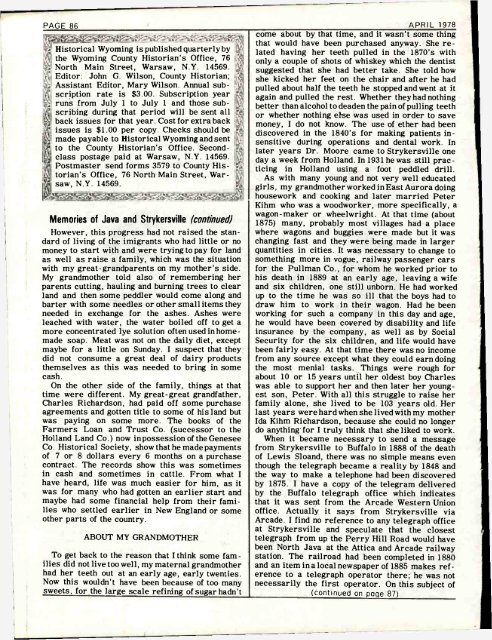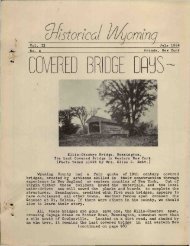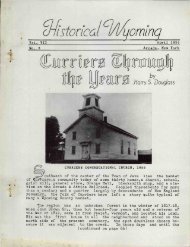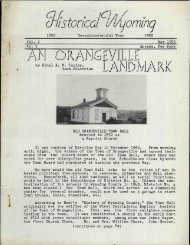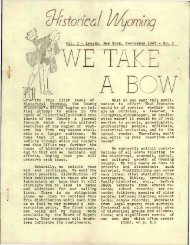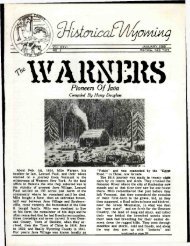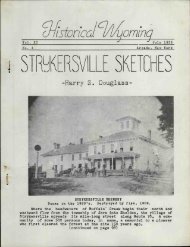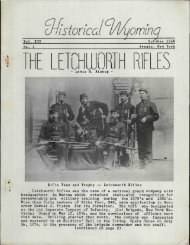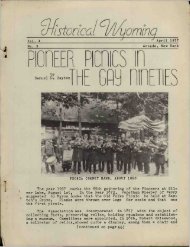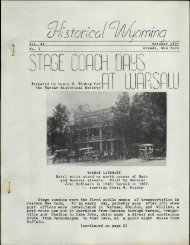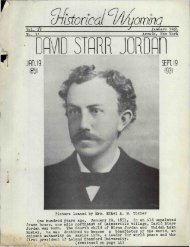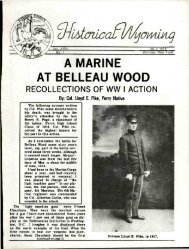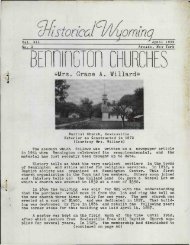By C. Kihm Richardson Walking from Strykersville ... - Fulton History
By C. Kihm Richardson Walking from Strykersville ... - Fulton History
By C. Kihm Richardson Walking from Strykersville ... - Fulton History
You also want an ePaper? Increase the reach of your titles
YUMPU automatically turns print PDFs into web optimized ePapers that Google loves.
PAGE 86<br />
Historical Wyoming is published quarterly by<br />
the Wyoming County Historian's Office, 76 jj<br />
North Main Street, Warsaw, N.Y. 14569.<br />
Editor: John G. Wilson, County Historian; Ij<br />
Assistant Editor, Mary Wilson. Annual sub- |<br />
scription rate is $3.00. Subscription year<br />
runs <strong>from</strong> July 1 to July 1 and those subscribing<br />
during that period will be sent all<br />
back issues for that year. Cost for extra back<br />
issues is $1.00 per copy. Checks should be<br />
made payable to Historical Wyoming and sent<br />
to the County Historian's Office. Secondclass<br />
postage paid at Warsaw, N.Y. 14569.<br />
Postmaster send forms 3579 to County Historian's<br />
Office, 76 North Main Street, Warsaw,<br />
N.Y. 14569.<br />
Memories of Java and <strong>Strykersville</strong> (continued)<br />
However, this progress had not raised the standard<br />
of living of the imigrants who had little or no<br />
money to start with and were trying to pay for land<br />
as well as raise a family, which was the situation<br />
with my great-grandparents on my mother's side.<br />
My grandmother told also of remembering her<br />
parents cutting, hauling and burning trees to clear<br />
land and then some peddler would come along and<br />
barter with some needles or other small items they<br />
needed in exchange for the ashes. Ashes were<br />
leached with water, the water boiled off to get a<br />
more concentrated lye solution often used in homemade<br />
soap. Meat was not on the daily diet, except<br />
maybe for a little on Sunday. I suspect that they<br />
did not consume a great deal of dairy products<br />
themselves as this was needed to bring in some<br />
cash.<br />
On the other side of the family, things at that<br />
time were different. My great-great grandfather,<br />
Charles <strong>Richardson</strong>, had paid off some purchase<br />
agreements and gotten title to some of his land but<br />
was paying on some more. The books of the<br />
Farmers Loan and Trust Co. (successor to the<br />
Holland Land Co.) now in possession of the Genesee<br />
Co. Historical Society, show that he made payments<br />
of 7 or 8 dollars every 6 months on a purchase<br />
contract. The records show this was sometimes<br />
in cash and sometimes in cattle. From what I<br />
have heard, life was much easier for him, as it<br />
was for many who had gotten an earlier start and<br />
maybe had some financial help <strong>from</strong> their families<br />
who settled earlier in New England or some<br />
other parts of the country.<br />
ABOUT MY GRANDMOTHER<br />
To get back to the reason that I think some families<br />
did not live too well, my maternal grandmother<br />
had her teeth out at an early age, early twenties.<br />
Now this wouldn't have been because of too many<br />
sweets, for the large scale refining of sugar hadn't<br />
APRIL 1978<br />
come about by that time, and it wasn't some thing<br />
that would have been purchased anyway. She related<br />
having her teeth pulled in the 1870's with<br />
only a couple of shots of whiskey which the dentist<br />
suggested that she had better take. She told how<br />
she kicked her feet on the chair and after he had<br />
pulled about half the teeth he stopped and went at it<br />
again and pulled the rest. Whether they had nothing<br />
better than alcohol to deaden the pain of pulling teeth<br />
or whether nothing else was used in order to save<br />
money, I do not know. The use of ether had been<br />
discovered in the 1840's for making patients insensitive<br />
during operations and dental work. In<br />
later years Dr. Moore came to <strong>Strykersville</strong> one<br />
day a week <strong>from</strong> Holland. In 1931 he was still practicing<br />
in Holland using a foot peddled drill.<br />
As with many young and not very well educated<br />
girls, my grandmother worked in East Aurora doing<br />
housework and cooking and later married Peter<br />
<strong>Kihm</strong> who was a woodworker, more specifically, a<br />
wagon-maker or wheelwright. At that time (about<br />
1875) many, probably most villages had a place<br />
where wagons and buggies were made but it was<br />
changing fast and they were being made in larger<br />
quantities in cities. It was necessary to change to<br />
something more in vogue, railway passenger cars<br />
for the Pullman Co., for whom he worked prior to<br />
his death in 1889 at an early age, leaving a wife<br />
and six children, one still unborn. He had worked<br />
up to the time he was so ill that the boys had to<br />
draw him to work in their wagon. Had he been<br />
working for such a company in this day and age,<br />
he would have been covered by disability and life<br />
insurance by the company, as well as by Social<br />
Security for the six children, and life would have<br />
been fairly easy. At that time there was no income<br />
<strong>from</strong> any source except what they could earn doing<br />
the most menial tasks. Things were rough for<br />
about 10 or 15 years until her oldest boy Charles<br />
was able to support her and then later her youngest<br />
son, Peter. With all this struggle to raise her<br />
family alone, she lived to be 103 years old. Her<br />
last years were hard when she lived with my mother<br />
Ida <strong>Kihm</strong> <strong>Richardson</strong>, because she could no longer<br />
do anything for I truly think that she liked to work.<br />
When it became necessary to send a message<br />
<strong>from</strong> <strong>Strykersville</strong> to Buffalo in 1888 of the death<br />
of Lewis Sloand, there was no simple means even<br />
though the telegraph became a reality by 1848 and<br />
the way to make a telephone had been discovered<br />
by 1875. I have a copy of the telegram delivered<br />
by the Buffalo telegraph office which indicates<br />
that it was sent <strong>from</strong> the Arcade Western Union<br />
office. Actually it says <strong>from</strong> <strong>Strykersville</strong> via<br />
Arcade. I find no reference to any telegraph office<br />
at <strong>Strykersville</strong> and speculate that the closest<br />
telegraph <strong>from</strong> up the Perry Hill Road would have<br />
been North Java at the Attica and Arcade railway<br />
station. The railroad had been completed in 1880<br />
and an item in a local newspaper of 1885 makes reference<br />
to a telegraph operator there; he was not<br />
necessarily the first operator. On this subject of<br />
(continued on page 87)


